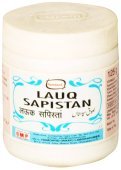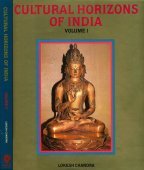Shan, Saṅ, Ṣaṇ, San, Saṇ, Śaṇ, Śān: 15 definitions
Introduction:
Shan means something in Hinduism, Sanskrit, Buddhism, Pali, the history of ancient India, Hindi, biology. If you want to know the exact meaning, history, etymology or English translation of this term then check out the descriptions on this page. Add your comment or reference to a book if you want to contribute to this summary article.
The Sanskrit terms Ṣaṇ and Śaṇ and Śān can be transliterated into English as San or Shan, using the IAST transliteration scheme (?).
Images (photo gallery)
(+6 more images available)
In Hinduism
Vyakarana (Sanskrit grammar)
Source: Wikisource: A dictionary of Sanskrit grammar1) Saṅ (सङ्).—A short term or प्रत्याहार (pratyāhāra) made up of the स (sa) of सन् (san) in गुप्तिज्किद्भ्यः सन् (guptijkidbhyaḥ san) P.III.1.5, and the ङ् (ṅ) of महिङ् (mahiṅ) in P.III.4.78 with a view to include all affixes from सन् (san) to महिङ् (mahiṅ); cf. सङि झलीति कुत्वादयो न सिध्यन्ति (saṅi jhalīti kutvādayo na sidhyanti), M. Bh. on P.VI,1.9 Vart. 7; cf also M. Bh. on P. VIII.2.22.
2) Saṇ (सण्).—tad. affix सण् (saṇ) prescribed after the word पर्शु (parśu) in the sense of collection; e. g. पार्श्र्वम् (pārśrvam); cf. पर्श्वाः सण् (parśvāḥ saṇ) P.IV.2.43 Vart. 3 for which there is an alternative reading पर्श्वा णस् वक्तव्यः (parśvā ṇas vaktavyaḥ); for facility of grammatical operations णस् (ṇas) is recommended with preference in the Mahabhasya; cf एवं तर्हि णस् वक्तव्य (evaṃ tarhi ṇas vaktavya); M.Bh. on P. IV.2.43 Vart. 3; (2) सण् (saṇ) is given as a technical term for संयोग (saṃyoga) in the Pratisakhya works; cf. सयुक् सण् । संयुक्तं व्यञ्जनं संयोगसंज्ञं भवति (sayuk saṇ | saṃyuktaṃ vyañjanaṃ saṃyogasaṃjñaṃ bhavati) R.T.27.
3) San (सन्).—(l)desiderative affix स (sa) applied to any root in the sense of desire; e. g. चिकीर्षति, जिहीर्षति, बुभूषति (cikīrṣati, jihīrṣati, bubhūṣati); cf धातोः कर्मणः समानकर्तृकादिदिच्छायां वा (dhātoḥ karmaṇaḥ samānakartṛkādidicchāyāṃ vā) P.III. 1.7; (2) applied in specific senses possessed by the root to the roots गुप्, तिज्, कित्, मान्, बध्, दान् (gup, tij, kit, mān, badh, dān) and शान् (śān); e.g. जुगुप्सते, तितिक्षते, चिकित्सति, मीमांसते, बीभत्सते, दीदांसते, शीशांसते (jugupsate, titikṣate, cikitsati, mīmāṃsate, bībhatsate, dīdāṃsate, śīśāṃsate); cf. P. III. 1. 5 and 6. The roots to which सन् (san) is applied are reduplicated and the reduplicated form ending with सन् (san) (स) is looked upon as a different root from the original one for purposes of conjugation, which takes, however, conjugational affixes of the same Pada as the original root; cf. सनाद्यन्ता धातवः (sanādyantā dhātavaḥ) III. 1.32.
4) Ṣaṇ (षण्).—A term used instead of the desiderative affix सन् (san) prescribed by P. III. 1.5 to 7, especially when the स् (s) of the affix is changed into ष् (ṣ) as for instance in तुष्टूषति (tuṣṭūṣati) etc.; cf. स्तौतेर्ण्यन्तानां षण्भूते च सनि परतः अभ्या-सादुत्तरस्य मूर्धन्यादेशो भवति (stauterṇyantānāṃ ṣaṇbhūte ca sani parataḥ abhyā-sāduttarasya mūrdhanyādeśo bhavati) Kas. on स्तौतिण्योरेव षण्यभासात् (stautiṇyoreva ṣaṇyabhāsāt) P. VIII.3.61.

Vyakarana (व्याकरण, vyākaraṇa) refers to Sanskrit grammar and represents one of the six additional sciences (vedanga) to be studied along with the Vedas. Vyakarana concerns itself with the rules of Sanskrit grammar and linguistic analysis in order to establish the correct context of words and sentences.
India history and geography
Source: Cologne Digital Sanskrit Dictionaries: Indian Epigraphical GlossarySan.—(IA 18), Arabic; a year; an era; sometimes used in Sanskrit records; in some cases, corrupted to sna. Note: san is defined in the “Indian epigraphical glossary” as it can be found on ancient inscriptions commonly written in Sanskrit, Prakrit or Dravidian languages.

The history of India traces the identification of countries, villages, towns and other regions of India, as well as mythology, zoology, royal dynasties, rulers, tribes, local festivities and traditions and regional languages. Ancient India enjoyed religious freedom and encourages the path of Dharma, a concept common to Buddhism, Hinduism, and Jainism.
Biology (plants and animals)
Source: Wisdom Library: Local Names of Plants and DrugsSan [सन] in the Hindi language is the name of a plant identified with Hibiscus cannabinus L. from the Malvaceae (Mallow) family. For the possible medicinal usage of san, you can check this page for potential sources and references, although be aware that any some or none of the side-effects may not be mentioned here, wether they be harmful or beneficial to health.
San [सन] in the Hindi language is the name of a plant identified with Crotalaria juncea L. from the Fabaceae (Pea) family having the following synonyms: Crotalaria sericea, Crotalaria benghalensis, Crotalaria viminea.
San [सन] in the Marathi language, ibid. previous identification.
San in the Urdu language, ibid. previous identification.
Source: Google Books: CRC World Dictionary (Regional names)1) San in India is the name of a plant defined with Crotalaria juncea in various botanical sources. This page contains potential references in Ayurveda, modern medicine, and other folk traditions or local practices It has the synonym Crotalaria juncea Willd. (among others).
2) San is also identified with Crotalaria pallida It has the synonym Crotalaria pallida Klotzsch (etc.).
3) San is also identified with Crotalaria verrucosa It has the synonym Anisanthera hastata Raf. (etc.).
4) San is also identified with Hibiscus cannabinus It has the synonym Abelmoschus verrucosus (Guill. & Perr.) Walp. (etc.).
5) San is also identified with Oryza sativa It has the synonym Oryza sativa var. rubribarbis Desv. (etc.).
6) San in Ivory Coast is also identified with Albizia adianthifolia It has the synonym Inga ferruginea Guill. & Perr. (etc.).
Example references for further research on medicinal uses or toxicity (see latin names for full list):
· Naturwissenschaftliche Reise nach Mossambique (1861)
· Notulae ad Plantas Asiaticas (1851)
· Cell and Chromosome Newsletter (1978)
· Florae Senegambiae Tentamen (1830)
· Proceedings of the Indian Science Congress Association (1987)
· Japanese Journal of Genetics (1991)
If you are looking for specific details regarding San, for example side effects, extract dosage, diet and recipes, chemical composition, health benefits, pregnancy safety, have a look at these references.

This sections includes definitions from the five kingdoms of living things: Animals, Plants, Fungi, Protists and Monera. It will include both the official binomial nomenclature (scientific names usually in Latin) as well as regional spellings and variants.
Languages of India and abroad
Pali-English dictionary
Source: Sutta: The Pali Text Society's Pali-English Dictionary1) San, 2 (=saṃ) Acc. of sa4. (Page 675)
2) San, 1 (cp. Vedic śvā, Gen. śunaḥ; Av. spā, Gr. ku/wn; Lat. canis, Oir. cū, Goth. hunds=hound) a dog; Nom. sg. sā D. I, 166=M. I, 77; S. I, 176; III, 150; Kvu 336. For other forms of the same base see suvāṇa. (Page 675)

Pali is the language of the Tipiṭaka, which is the sacred canon of Theravāda Buddhism and contains much of the Buddha’s speech. Closeley related to Sanskrit, both languages are used interchangeably between religions.
Sanskrit dictionary
Source: DDSA: The practical Sanskrit-English dictionaryŚaṇ (शण्).—1 P. (śaṇati) To give.
--- OR ---
Śān (शान्).—1 U. (śīśāṃsati-te, strictly a desiderative of śān used in a primitive sense) To sharpen, whet.
--- OR ---
San (सन्).—1 P., 8 U. (sanati, sanoti, sanute, sāta; pass. sanyate, sāyate; desid. sisaniṣati; siṣāsati)
1) To love, like.
2) To worship, honour.
3) To acquire, obtain.
4) To receive graciously.
5) To honour with gifts, give, bestow, distribute.
Source: Cologne Digital Sanskrit Dictionaries: Shabda-Sagara Sanskrit-English DictionaryŚaṇ (शण्).—r. 1st cl. (śaṇati) 1. To give. 2. To move.
--- OR ---
Śān (शान्).—r. 1st cl. intensitive form (śīśāṃsati-te) To whet, to sharpen.
--- OR ---
Ṣaṇ (षण्).—[(u)ṣaṇu] r. 8th cl. (sanoti sanute) 1. To give. 2. To serve or honour; also written ṣan .
--- OR ---
Ṣan (षन्).—[(u)ṣanu] r. 8th cl. (sanoti sanute) To give; also ṣaṇ .
Source: Cologne Digital Sanskrit Dictionaries: Benfey Sanskrit-English DictionaryŚaṇ (शण्).—i. 1, [Parasmaipada.] 1. To give (cf. śraṇ). 2. To move(?).
--- OR ---
Śān (शान्).— (properly a [denominative.] derived from śāna), used only in the anomal. desider. śīśāṃsa, [Parasmaipada.] [Ātmanepada.] To whet, to sharpen.
--- OR ---
San (सन्).—i. 1, [Parasmaipada.], ii. 8, [Parasmaipada.] [Ātmanepada.] 1. † To honour. 2. To obtain. 3. To give. Desider. siṣāsa, To wish to obtain (aid),
San (सन्).—sanoti (sanati), [participle] sāta win, conquer, acquire; receive as a present, possess, enjoy; win for another, procure, grant, bestow. [Desiderative] siṣāsati wish to acquire, strive after; wish to present or bestow.
--- OR ---
Sān (सान्).—breathe, live.
Sān is a Sanskrit compound consisting of the terms sa and an (अन्).
Source: Cologne Digital Sanskrit Dictionaries: Monier-Williams Sanskrit-English Dictionary1) Śaṇ (शण्):—[class] 1. 10. [Parasmaipada] śaṇati, śaṇayati, to give;
—to go, [Dhātupāṭha xix, 35.]
2) Śān (शान्):—(for √śo), only in [Desiderative] [Ātmanepada] śīśāṃsate, to whet, sharpen, [Dhātupāṭha xxiii, 26] (cf. [Pāṇini 3-1, 6]).
3) Ṣaṇ (षण्):—[from ṣaṣ] in [compound] for ṣaṣ.
4) San (सन्):—[from sat] a in [compound] for sat.
5) 1. san [class] 1. [Parasmaipada], [class] 8. [Ātmanepada] [Parasmaipada] ([Dhātupāṭha xiii, 21; xxx, 2]) sanati, te or sanoti, sanute ([Ātmanepada] rare and only in non-conjugational tenses; [perfect tense] sasāna, [Ṛg-veda]; p. sasavas, [ib.] f. sasanuṣī, [Brāhmaṇa]; sasanivas or senivas [grammar]; sene, [ib.]; [Aorist] asāniṣam [Subj. saniṣat [Ātmanepada] saniṣāsmahe, saniṣanta] [Ṛg-veda]; [imperative] saniṣantu, [Sāma-veda]; seṣam, set, [Maitrāyaṇī-saṃhitā; Brāhmaṇa]; asāta [grammar]; Prec. sanyāt, sāyāt, [ib.]; [future] sanitā, [ib.]; saniṣyati, [Ṛg-veda; Brāhmaṇa]; [infinitive mood] sanitum [grammar]),
—to gain, acquire, obtain as a gift, possess, enjoy, [Ṛg-veda; Atharva-veda; Brāhmaṇa; ???];
—to gain for another, procure, bestow, give, distribute, [Ṛg-veda];
— ([Ātmanepada]) to be successful, be granted or fulfilled, [ib.] :—[Passive voice] sanyate or sāyate, [Pāṇini 6-4, 43] :—[Causal] sānayati ([Aorist] asīṣaṇat) [grammar]:—[Desiderative] of [Causal] sisānayiṣati, [ib.] :
—[Desiderative] sisaniṣati ([grammar]) or siṣāsati (? sīṣatī, [Atharva-veda iv, 38, 2]), to wish to acquire or obtain, [Ṛg-veda; Taittirīya-saṃhitā; Atharva-veda];
—to wish to procure or bestow, [Ṛg-veda; Atharva-veda] :—[Intensive] saṃsanyate, sāsāyate, saṃsanti ([grammar]), to gain or acquire repeatedly (only 3. [plural] saniṣṇata, [Ṛg-veda i, 131, 5]).
6) 2. san in go-ṣan q.v.
7) 3. san (in gram.) a technical term for the syllable sa or sign of the desiderative.
8) 4. san Name of an era (current in Bengal and reckoned from 593 A.D.), [Religious Thought and Life in India 433].
Source: Cologne Digital Sanskrit Dictionaries: Yates Sanskrit-English Dictionary1) Śaṇ (शण्):—śaṇati 1. a. To give; to move.
2) Śān (शान्):—śiśāṃsati, te intens. c. To whet, sharpen.
3) Ṣaṇ (षण्):—(da, ña, u) sanoti sanute 8. c. To give; to serve or honor.
4) Ṣan (षन्):—(da, ña, ṅa) sanoti sanute 8. c. To give.
[Sanskrit to German]
Sanskrit, also spelled संस्कृतम् (saṃskṛtam), is an ancient language of India commonly seen as the grandmother of the Indo-European language family (even English!). Closely allied with Prakrit and Pali, Sanskrit is more exhaustive in both grammar and terms and has the most extensive collection of literature in the world, greatly surpassing its sister-languages Greek and Latin.
Hindi dictionary
Source: DDSA: A practical Hindi-English dictionary1) Shan in Hindi refers in English to:—(nf) magnificence, splendour, grandeur; pomp; a touchstone; whetting; ~[ci] boastful; a brag, braggadocio; ~[dara] magnificent; pompous, splendid, grand; -[shaukata] pomp and show, grandeur and splendour; —[cadhana] to whet, to give pointedness/intensity; —[dikhana] to do the grand; —[dharana] to whet, to sharpen;—[bagharana/marana] to give oneself airs, to ride the high horse; to boast, to brag; —[barasana] to look grand or grandly impressive, to be a picture of grandeur; -[bana] grandeur, magnificence; pomp and show; —[mem, kisi ki] undermining the honour/prestige of (as [unaki shana mem aisi bata nahim kahani cahie thi]); —[mem pharka ana] one’s honour/prestige to be undermined/jeopardised; —[mem batta lagana] a fair name to be tarnished..—shan (शान) is alternatively transliterated as Śāna.
2) Ṣaṇ (षण्):——an allomorph of [ṣaṭ] (six) appearing as the first member in some compound words; ~[māsika] six-monthly; ~[mukha] six-faced (viz. [kārtikeya]—the god of war).
3) San in Hindi refers in English to:—(nm) a year; an era; a kind of jute, hemp; (nf) whizzing sound; (a) stupefied; —[ki rassi] a hemp-rope; ~[sana] whizzing sound; —[se nikala jana] to pass with a whizzing sound; to pass with extra-ordinary speed..—san (सन) is alternatively transliterated as Sana.
4) San (सन्):—(nm) an era, a year; —, [īsvī] the Christian era; —, [hijarī] Mohammedan era.
...
Kannada-English dictionary
Source: Alar: Kannada-English corpusSan (ಸನ್):—[noun] a year of any calendar.
Kannada is a Dravidian language (as opposed to the Indo-European language family) mainly spoken in the southwestern region of India.
Nepali dictionary
Source: unoes: Nepali-English DictionarySan (सन्):—n. 1. a year (of the Christian calendar); 2. era;
Nepali is the primary language of the Nepalese people counting almost 20 million native speakers. The country of Nepal is situated in the Himalaya mountain range to the north of India.
See also (Relevant definitions)
Partial matches: Aan, An, Ca, Sha.
Starts with (+27): Samkoca, Sanmatra, Sannada, Sannagarika, Sannidhana, Shana, Shanacurna, Shanagaura, Shanaghantika, Shanajiva, Shanakulaya, Shanamaya, Shanapada, Shanaparni, Shanapatta, Shanaphala, Shanapramana, Shanapushpi, Shanapushpika, Shanapushpike.
Query error!
Full-text (+1255): Samkoca, Shanmukha, Shankari, Samgraha, Samghata, Samgata, Sannaddha, Sannidhana, Shanmasa, Sankrama, Shanmasika, Samghatta, Samkalana, Samdesha, Samgara, Samkshobha, Samkhyana, Prasan, Sangati, Sannivesha.
Relevant text
Search found 241 books and stories containing Shan, Saṅ, Ṣaṇ, San, Saṇ, Śaṇ, Śān, Ṣan, Sān, Sa-an, Shaan; (plurals include: Shans, Saṅs, Ṣaṇs, Sans, Saṇs, Śaṇs, Śāns, Ṣans, Sāns, ans, Shaans). You can also click to the full overview containing English textual excerpts. Below are direct links for the most relevant articles:
Three Shan texts < [Volume 26 (1961)]
Essentials of Khün phonology and script < [Volume 24 (1959)]
An annotated syllabary of Sathewok Hakka < [Volume 28 (1963)]
Kathasaritsagara (the Ocean of Story) (by Somadeva)
Note on gambling in ancient India < [Notes]
Part 4 - Assam, Burma, Annam and Siam < [Appendix 8.2 - The Romance of Betel-Chewing]
Notes on sign language (the method of communicating by signs ) < [Notes]
Shurangama Sutra (with commentary) (English) (by Hsuan Hua)
The five sections of the Spiritual Mantra, the Shurangama Mantra < [Chapter 3 - The Spiritual Mantra]
“Born Into Emptiness”: the mind organ < [Chapter 2 - Twenty-five Means to Enlightenment]
Suppression of the self leads to sadness < [Chapter 3 - The Feeling Skandha]
World Journal of Pharmaceutical Research
Application of yogya vidhi in otorhinolaryngology temporal bone. < [2020: Volume 9, February issue 2]
Link between Senecio biomass and elevation in Shan County < [2021: Volume 10, December issue 14]
Liquid Biopsy: Innovations in Cancer Detection and Treatment Monitoring < [2023: Volume 12, June special issue 10]
The concept of Yoga in Yoga Upanishads (by Philomina T.L)
7. The Scientific Interpretations of the Yogopaniṣads < [Chapter 5 - Textual Analysis]
4. Description of Karmayoga and Jñānayoga < [Chapter 4 - The contents of the Yogopaniṣads]
15. Rules of Yoga < [Chapter 4 - The contents of the Yogopaniṣads]
Rig Veda (translation and commentary) (by H. H. Wilson)
Related products









